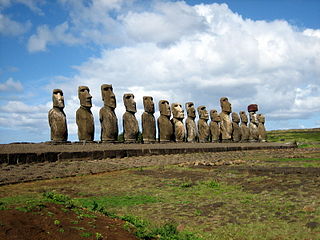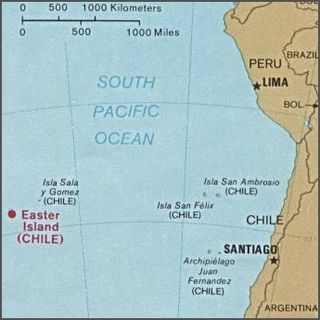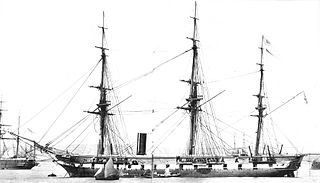
Thor Heyerdahl KStJ was a Norwegian adventurer and ethnographer with a background in biology with specialization in zoology, botany and geography.

Easter Island is an island and special territory of Chile in the southeastern Pacific Ocean, at the southeasternmost point of the Polynesian Triangle in Oceania. The island is most famous for its nearly 1,000 extant monumental statues, called moai, which were created by the early Rapa Nui people. In 1995, UNESCO named Easter Island a World Heritage Site, with much of the island protected within Rapa Nui National Park.

Moai or moʻai are monolithic human figures carved by the Rapa Nui people on Rapa Nui in eastern Polynesia between the years 1250 and 1500. Nearly half are still at Rano Raraku, the main moai quarry, but hundreds were transported from there and set on stone platforms called ahu around the island's perimeter. Almost all moai have overly large heads, which account for three-eighths of the size of the whole statue. They also have no legs. The moai are chiefly the living faces of deified ancestors.

Rano Raraku is a volcanic crater formed of consolidated volcanic ash, or tuff, and located on the lower slopes of Terevaka in the Rapa Nui National Park on Easter Island in Chile. It was a quarry for about 500 years until the early eighteenth century, and supplied the stone from which about 95% of the island's known monolithic sculptures (moai) were carved. Rano Raraku is a visual record of moai design vocabulary and technological innovation, where 887 moai remain. Rano Raraku is in the World Heritage Site of Rapa Nui National Park and gives its name to one of the seven sections of the park.

Katherine Maria Routledge was an English archaeologist and anthropologist who, in 1914, initiated and carried out much of the first true survey of Easter Island.

Pukao are the hat-like structures or topknots formerly placed on top of some moai statues on Easter Island. They were all carved from a very light-red volcanic scoria, which was quarried from a single source at Puna Pau.

Aku-Aku: the Secret of Easter Island is a 1957 book by Thor Heyerdahl published in Norwegian, Swedish, Danish and Finnish, and in French and English the following year. The book describes the 1955–1956 Norwegian Archaeological Expedition's investigations of Polynesian history and culture at Easter Island, the Austral Islands of Rapa Iti and Raivavae, and the Marquesas Islands of Nuku Hiva and Hiva Oa. Visits to Pitcairn Island, Mangareva and Tahiti are described as well.

The Tangata manu was the winner of a traditional ritual competition on Rapa Nui to collect the first sooty tern egg of the season from the nearby islet of Motu Nui, swim back to Rapa Nui, and climb the sea cliffs of Rano Kau to the clifftop village of Orongo.

Makemake in the Rapa Nui mythology of Easter Island is the creator of humanity, the god of fertility and the chief god of the "Tangata manu" or bird-man sect. He appeared to be the local form, or name, of the old Polynesian god Tane. He had no wife.

Hoa Hakananai'a is a moai, a statue from Easter Island. It was taken from Orongo, Easter Island in 1868 by the crew of a British ship and is now in the British Museum in London.

Poike is one of the three main extinct volcanoes that form Rapa Nui, a Chilean island in the Pacific Ocean. At 370 metres above sea level, Poike's peak is the island's second-highest point after the peak of the extinct volcano Terevaka.

Rano Kau is a 324 m (1,063 ft) tall extinct volcano that forms the southwestern headland of Easter Island, a Chilean island in the Pacific Ocean. It was formed of basaltic lava flows in the Pleistocene with its youngest rocks dated at between 150,000 and 210,000 years ago.

Geologically one of the youngest inhabited territories on Earth, Easter Island, located in the mid-Pacific Ocean, was, for most of its history, one of the most isolated. Its inhabitants, the Rapa Nui, have endured famines, epidemics of disease, civil war, environmental collapse, slave raids, various colonial contacts, and have seen their population crash on more than one occasion. The ensuing cultural legacy has brought the island notoriety out of proportion to the number of its inhabitants.

HMS Topaze was a 51-gun Liffey-class wooden screw frigate of the Royal Navy. She was launched on 12 May 1858, at Devonport Dockyard, Plymouth.
Jo Anne Van Tilburg is an American archaeologist best known for her research on the statues of Easter Island. Her primary specialty is rock art.

William Scoresby Routledge, FRGS (1859–1939) was a British ethnographer, anthropologist and adventurer. With his wife, Katherine Routledge, he completed the first ethnographies of the Kikuyu and the people of Rapa Nui.

Hotu-iti is an area of southeastern Easter Island that takes its name from a local clan. Located in Rapa Nui National Park, the area includes Rano Raraku crater, the Ahu Tongariki site, and a small bay. In the 15th and 16th centuries, the Hotu-iti clan was one of two polities on Easter Island.

Angata, full name María Angata Veri Tahi ʻa Pengo Hare Koho was a Roman Catholic Rapa Nui religious leader from Easter Island during the late 19th and early 20th century. After experiencing a prophetic vision in which God instructed her to retake the land and livestock, she led an unsuccessful rebellion on the island against the Williamson-Balfour Company, intending to create a theocracy centered on Roman Catholicism and Rapa Nui spiritual values.

Juan Tepano Rano ʻa Veri ʻAmo was a Rapa Nui leader of Easter Island. He served as an informant for Euro-American scholars on the culture and history of the island.
Moisés Jacob Tu‘u Hereveri was elected ‘ariki (king) of Rapa Nui from 1901 until 1902. He was the last Rapa Nui to claim the traditional kingship in the early 20th-century. However, he is not remembered as the last king instead his predecessor Riro Kāinga is generally regarded as the last king, although neither held much power. Variation of his family name included Hereveri, Here Veri, Veri-Veri, Beri-Beri, Tueri-Beri, Tueriveri, or Tueriveri.



















